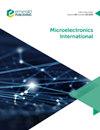An investigation of physical properties and photovoltaic performance of methylammonium lead-tin iodide (CH3NH3Sn1-xPbxI3) solar cells
IF 0.8
4区 工程技术
Q4 ENGINEERING, ELECTRICAL & ELECTRONIC
引用次数: 0
Abstract
In the past several years, CH3NH3PbI3 perovskite material has been extensively evaluated as an absorber layer of perovskite solar cells due to its excellent structural and optical properties, and greater than 22% conversion efficiency. However, improvement and future commercialization of solar cells based on CH3NH3PbI3 encountered restrictions due to toxicity and instability of the lead element. Recently, studies on properties of lead-free and mixture of lead with other cations perovskite thin films as light absorber materials have been reported. The purpose of this paper was the fabrication of CH3NH3Sn1-xPbxI3 thin films with different SnI2 concentrations in ambient condition, and study on the structural, morphological, optical, and photovoltaic performance of the studied solar cells. The X-ray diffraction studies revealed the formation of both CH3NH3PbI3 and CH3NH3SnI3 phases with increasing the Sn concentration, and improvement in crystallinity and morphology was also observed. All perovskite layers had a relatively high absorption coefficient >104 cm−1 in the visible wavelengths, and the bandgap values varied in the range from 1.46 to 1.63 eV. Perovskite solar cells based on these thin films have been fabricated, and device performance was investigated. Results showed that photo-conversion efficiency (PCE) for the pure CH3NH3PbI3sample was 1.20%. With adding SnI2, PCE was increased to 4.48%.,In this work, the author mixed tin and lead with different percentages in the perovskite thin film. Also, the preparation of these layers and also other layers to fabricate solar cells based on them were conducted in an open and non-glove box environment. Finally, the effect of [Sn/Pb] ratio in the CH3NH3Sn1-xPbxI3 layers on the structural, morphological, optical, electrical and photovoltaic performance have been investigated.,CH3NH3Sn1-xPbxI3 (x = 0.0, 0.25, 0.50, 0.75, 1.0) perovskite thin films have been grown by a spin-coating technique. It was found that as tin concentration increases, the X-ray diffraction and FESEM images studies revealed the formation of both CH3NH3PbI3 and CH3NH3SnI3 phases, and improvement in crystallinity, and morphology; all thin films had high absorption coefficient values close to 104 cm−1 in the visible region, and the direct optical bandgap in the layers decreases from 1.63 eV in pure CH3NH3SnI3 to 1.46 eV for CH3NH3Sn0.0.25Pb0.75I3 samples; all thin films had p-type conductivity, and mobility and carrier density increased; perovskite solar cells based on these thin films have been fabricated, and device performance was investigated. Results showed that photo-conversion efficiency (PCE) for the pure CH3NH3PbI3sample was 1.20%. With adding SnI2, PCE was increased to 4.48%.,The preparation method seems to be interesting as it is in an ambient environment without the protection of nitrogen or argon gas.甲基铵-铅-锡碘化物(CH3NH3Sn1-xPbxI3)太阳能电池物理性能和光伏性能的研究
在过去的几年里,CH3NH3PbI3钙钛矿材料由于其优异的结构和光学性能以及大于22%的转换效率而被广泛评价为钙钛矿太阳能电池的吸收层。然而,由于铅元素的毒性和不稳定性,基于CH3NH3PbI3的太阳能电池的改进和未来的商业化遇到了限制。近年来,人们对无铅和铅与其他阳离子的混合物钙钛矿薄膜作为吸光材料的性能进行了研究。本文的目的是在环境条件下制备不同SnI2浓度的CH3NH3Sn1-xPbxI3薄膜,并研究所研究的太阳能电池的结构、形态、光学和光伏性能。X射线衍射研究表明,随着Sn浓度的增加,CH3NH3PbI3和CH3NH3SnI3相都形成了,并且还观察到结晶度和形态的改善。所有钙钛矿层都具有相对较高的吸收系数>104 cm−1,带隙值在1.46到1.63之间变化 基于这些薄膜制备了钙钛矿太阳能电池,并对其器件性能进行了研究。结果表明,纯CH3NH3PbI3样品的光转换效率(PCE)为1.20%,随着SnI2的加入,PCE提高到4.48%。此外,这些层以及用于制造基于它们的太阳能电池的其他层的制备是在开放和非手套箱环境中进行的。最后,研究了CH3NH3Sn1-xPbxI3层中[Sn/Pb]比例对结构、形态、光学、电学和光伏性能的影响。,通过旋涂技术生长了CH3NH3Sn1-xPbxI3(x=0.0、0.25、0.50、0.75、1.0)钙钛矿薄膜。研究发现,随着锡浓度的增加,X射线衍射和FESEM图像研究揭示了CH3NH3PbI3和CH3NH3SnI3相的形成,以及结晶度和形态的改善;所有薄膜都具有接近104的高吸收系数值 cm−1,并且层中的直接光学带隙从1.63减小 纯CH3NH3SnI3中的eV至1.46 CH3NH3Sn0.0.25Pb0.75I3样品的eV;所有薄膜都具有p型导电性,并且迁移率和载流子密度增加;基于这些薄膜制备了钙钛矿太阳能电池,并对其器件性能进行了研究。结果表明,纯CH3NH3PbI3样品的光转换效率(PCE)为1.20%。随着SnI2的加入,PCE提高到4.48%。这种制备方法似乎很有趣,因为它是在没有氮气或氩气保护的环境中进行的。
本文章由计算机程序翻译,如有差异,请以英文原文为准。
求助全文
约1分钟内获得全文
求助全文
来源期刊

Microelectronics International
工程技术-材料科学:综合
CiteScore
1.90
自引率
9.10%
发文量
28
审稿时长
>12 weeks
期刊介绍:
Microelectronics International provides an authoritative, international and independent forum for the critical evaluation and dissemination of research and development, applications, processes and current practices relating to advanced packaging, micro-circuit engineering, interconnection, semiconductor technology and systems engineering. It represents a current, comprehensive and practical information tool. The Editor, Dr John Atkinson, welcomes contributions to the journal including technical papers, research papers, case studies and review papers for publication. Please view the Author Guidelines for further details.
Microelectronics International comprises a multi-disciplinary study of the key technologies and related issues associated with the design, manufacture, assembly and various applications of miniaturized electronic devices and advanced packages. Among the broad range of topics covered are:
• Advanced packaging
• Ceramics
• Chip attachment
• Chip on board (COB)
• Chip scale packaging
• Flexible substrates
• MEMS
• Micro-circuit technology
• Microelectronic materials
• Multichip modules (MCMs)
• Organic/polymer electronics
• Printed electronics
• Semiconductor technology
• Solid state sensors
• Thermal management
• Thick/thin film technology
• Wafer scale processing.
 求助内容:
求助内容: 应助结果提醒方式:
应助结果提醒方式:


